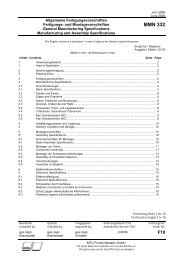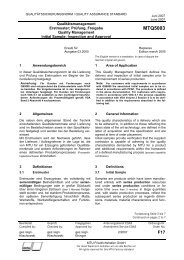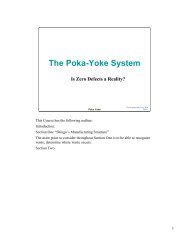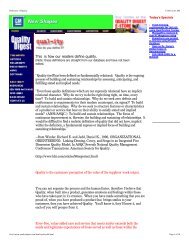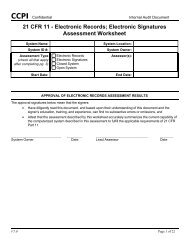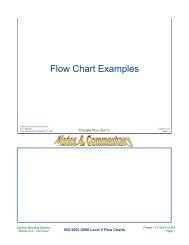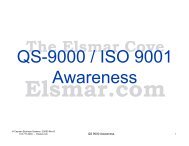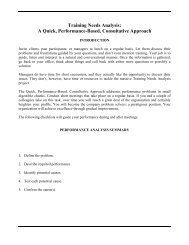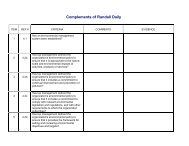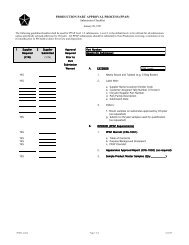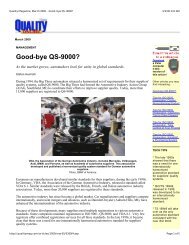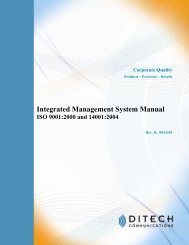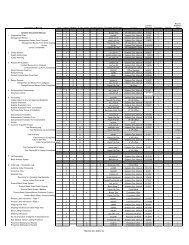Global Automotive Declarable Substance List (GADSL)
Global Automotive Declarable Substance List (GADSL)
Global Automotive Declarable Substance List (GADSL)
You also want an ePaper? Increase the reach of your titles
YUMPU automatically turns print PDFs into web optimized ePapers that Google loves.
<strong>Global</strong> <strong>Automotive</strong> <strong>Declarable</strong> <strong>Substance</strong> <strong>List</strong> (<strong>GADSL</strong>)<br />
1. <strong>GADSL</strong> Objectives<br />
Major objectives of automotive product development include continuous improvements<br />
in quality, safety, and the reduction of environmental impact throughout vehicle life<br />
cycle. As much as possible, these objectives should be achieved in an efficient, cost<br />
effective way to optimize consumer value. A large number of construction, operational<br />
and processing materials are used in the automotive manufacturing chain, and their<br />
selection and proper use can have significant impact on these objectives.<br />
To meet these objectives, an ongoing dialogue and information flow within the global<br />
automotive supply chain, including automobile manufacturers, tier suppliers and<br />
material suppliers has been established, called the <strong>Global</strong> <strong>Automotive</strong> Stakeholder<br />
Group (GASG). Early information and dialogue up and down the supply chain will help<br />
facilitate compliance with current and future regulations, as well as take into account<br />
customer requirements to ensure sustainable products. Optimized handling of relevant<br />
information flow can help automobile manufacturers meet existing and projected<br />
reporting requirements in a consistent, understandable and efficient way.<br />
The GASG organization consists of three regions, Americas, Europe/Africa/Middle East,<br />
and Asia/Pacific. Regional membership and participation is open to all stakeholders in<br />
the automotive supply chain. Each of the three regions nominates six members to sit on<br />
the governing body of the GASG, called the Steering Committee (SC). The SC meets<br />
annually or more at its prerogative to decide on the <strong>GADSL</strong> and to provide a transparent<br />
and open process for decision making.<br />
The product of the GASG dialogue is the <strong>Global</strong> <strong>Automotive</strong> <strong>Declarable</strong> <strong>Substance</strong> <strong>List</strong><br />
(<strong>GADSL</strong>). The <strong>GADSL</strong> covers declaration of certain information about substances<br />
relevant to parts and materials supplied by the supply chain to automobile<br />
manufacturers. The information is applicable to the use of these parts or materials in the<br />
production of a vehicle up to its usage and relevant to the vehicle’s re-use or waste<br />
disposal.<br />
Revision Date Revision Comment<br />
2008-09-01 Update of new Directive number to ELV Annex II and REACH<br />
2009-02-01 Update of the substance list according to agreed dossiers.<br />
2009 changes are highlighted in gray.<br />
2009-03-31 Corrected reference to the Canadian Environmental Protection Ac t<br />
2009 <strong>GADSL</strong> Version 1.0 Page 1 of 44
The intent of <strong>GADSL</strong> is to become the company specific list for declaration of parts<br />
composition within the automotive industry. It provides a definitive list of substances<br />
requiring declaration with the target to minimize individual requirements and ensure<br />
cost-effective management of declaration practice along the complex supply chain. The<br />
scope is to cover declarable substances in the flow of information relevant to parts and<br />
materials supplied throughout the automotive value chain, from production to the end of<br />
life phase. The <strong>GADSL</strong> only covers substances that are expected to be present in<br />
a material or part that remains in the vehicle or part at point of sale.<br />
This approach is a voluntary industry initiative designed to ensure integrated,<br />
responsible and sustainable product development by automobile manufacturers and<br />
their supply chain. Its purpose is to minimize individual requirements and ensure costeffective<br />
management of declaration practice along the large and complex global supply<br />
chain.<br />
2. Application of the <strong>GADSL</strong><br />
The use of certain substances in vehicle parts may be a risk factor to human health and<br />
the environment. Information exchange along the vehicle supply chain helps manage<br />
those potential risks while also meeting customer requirements. The <strong>GADSL</strong> is used to<br />
enhance further dialogue and cooperation along the supply chain on the benefits and<br />
potential risks of certain substances or groups of substances in a specified use within<br />
vehicle parts/materials. Declaration of a substance does not mean, however, that the<br />
substance is prohibited from being used in vehicle parts or is to be de-selected from<br />
use. Any declaration process using the <strong>GADSL</strong> must respect the framework formulated<br />
in this preface.<br />
Definitions<br />
<strong>Substance</strong>s Chemical elements or chemical compounds as parts of materials or<br />
preparations<br />
Preparations Mixtures, composed of two or more substances<br />
Materials Chemical elements, chemical compounds or preparations thereof in<br />
finished state used to manufacture products/articles<br />
Products/articles Materials, which have been transformed during production to take a<br />
specific shape, surface or form, which has a greater influence on<br />
their function than their chemical composition does.<br />
Parts Single components made up of one or more homogenous<br />
material(s)<br />
2009 <strong>GADSL</strong> Version 1.0 Page 2 of 44
Criteria for <strong>Declarable</strong> <strong>Substance</strong>s<br />
The decision to list a substance on the <strong>GADSL</strong> is based on the following criteria:<br />
• The substance should be expected to be present in a material or part in the vehicle.<br />
Either of the following conditions should apply:<br />
The substance is regulated 1 , or is projected to be regulated by a governmental<br />
agency or authority, or<br />
It is demonstrated, by testing under OECD (Organization for Economic<br />
Cooperation & Development) guidelines for testing chemicals, conducted under<br />
Good Laboratory Practice (according to the OECD Principles on Good<br />
Laboratory Practice as revised in 1997), that the substance may be associated<br />
with a significant hazard to human health and/or the environment, and its<br />
presence in a material or part in a vehicle may create a significant risk to human<br />
health and/or the environment. Other scientifically valid methodology, based on<br />
the weight of evidence, may also be considered.<br />
• A substance that causes a functional problem in vehicle design may be included if its<br />
presence in a vehicle part exceeds a level shown to be problematic by an<br />
international industry standard test 2 .<br />
• Reportable threshold levels will be based on the lowest level required by regulation<br />
or reasonably required by scientific evaluation.<br />
<strong>Declarable</strong> <strong>Substance</strong> Classification<br />
A reportable substance when present in a material or part in a vehicle will be shown on<br />
the <strong>GADSL</strong> with a classification of “P” or “D”, defined as follows:<br />
Depending on its specific application, the same substance could be classified “P” in one<br />
end use, and “D” in another end use. When this is the case, both classifications for the<br />
substance will be shown on the <strong>GADSL</strong> with examples under the application column.<br />
Declaration thresholds are defined by specific application of the substance in<br />
automotive parts. Any reportable substance below the declaration level does not have<br />
to be reported. These levels, unless otherwise indicated, are 0.1 g/100g (weight %) of<br />
non-separable, homogeneous materials, not on the total content in the component or<br />
assembly.<br />
P = Prohibited<br />
A substance designated “P” is either prohibited by regulation for use in certain<br />
applications or may not exceed regulated threshold limits.<br />
1 Due to potential effects on human health or the environment related to the <strong>Automotive</strong> industry<br />
2 Examples would be emissions, like odor testing or fogging. Currently there are numerous tests.<br />
Development of a quantitative industry standard test would reduce resource requirement and uncertainty<br />
for the supply chain.<br />
2009 <strong>GADSL</strong> Version 1.0 Page 3 of 44
D = <strong>Declarable</strong><br />
A substance designated “D” must be declared if it exceeds the defined threshold limits.<br />
Reason Codes<br />
Reason codes have been developed to explain why a substance has been included in<br />
the <strong>GADSL</strong>. Each declarable substance will be listed with one of the following reason<br />
codes to facilitate dialog within the supply chain:<br />
LR = Legally Regulated<br />
A substance legally regulated because its use in a vehicle part or material poses a<br />
significant risk to health and or the environment.<br />
FA = For Assessment<br />
A substance projected to be regulated by government agencies, upon decision by the<br />
GASG Steering Committee.<br />
FI = For Information<br />
A substance tracked for information purposes only, upon decision by the GASG<br />
Steering Committee. After discussion at the GASG Steering Committee and on an<br />
exceptional basis, an automobile manufacturer may include an individual substance or<br />
family of substances on the list under this (FI) reason code.<br />
LR, FA and FI substances should not be construed to mean that the substance is<br />
prohibited from being used in a vehicle part, or is to be de-selected from use.<br />
<strong>Substance</strong> families: If all members of a substance family are “D” or “P” the entry “All<br />
members” is listed after the family name. The entry “substance name, selected” means:<br />
This substance family refers to a limited list of single substances, which meet the criteria<br />
for being declarable or prohibited.<br />
In certain cases substance families have the classification "D, except". This means that<br />
all substances within that family are declarable except those that are listed directly<br />
below labeled with "P" (e.g. Polybrominated Diphenyl Ethers).<br />
CAS numbers for individual substances of a chemical family or group on the <strong>GADSL</strong> are<br />
listed in the Reference <strong>List</strong> which is part of <strong>GADSL</strong>. This list is available on the <strong>GADSL</strong><br />
website. A 2006 priority of the GASG will be to review individual substances identified<br />
by CAS numbers on the reference list against <strong>GADSL</strong> criteria. The sole purpose of this<br />
reference list is to facilitate communication and declaration relating to the <strong>GADSL</strong> within<br />
the automotive supply chain to the automobile manufacturers.<br />
2009 <strong>GADSL</strong> Version 1.0 Page 4 of 44
3. <strong>GADSL</strong> Validity<br />
The valid <strong>GADSL</strong> will be the current English version on http://www.gadsl.org. The<br />
content of the <strong>GADSL</strong> and its application does not relieve parties in the supply chain<br />
from obligation to comply with all existing relevant regional and national regulations in<br />
their business to business dealings.<br />
4. Change Management Process<br />
The <strong>GADSL</strong> will be updated and published annually in February according to improved<br />
knowledge in order to achieve a high standard of product safety and environment<br />
protection. At the latest 12 months after the publication date, any declaration should be<br />
performed according to this updated version.<br />
Requested changes to the <strong>GADSL</strong> must be received by July 15 each year in order to be<br />
considered for the next version. For this input, comments and questions please contact<br />
one of the persons listed on the <strong>GADSL</strong> website.<br />
5. <strong>List</strong>ed substances<br />
The table on the following pages shows the substances that are covered by the <strong>GADSL</strong>.<br />
Any substance name that has "all members" after the name is to be considered as a<br />
group name covering several individual substances. Every attempt has been made to<br />
include a complete list of the members of the family. For a listing of those potentially<br />
individual relevant substances, please refer to the "Reference <strong>List</strong>" that can be found on<br />
the <strong>GADSL</strong> website.<br />
Any substance where the substance name is followed by the word “selected” means<br />
that the list in the reference list will not be a complete listing but will show only those<br />
members that are to be reported, whether they are classified as “P” or “D.”<br />
6. Use of <strong>GADSL</strong><br />
<strong>GADSL</strong> was created by GASG. <strong>GADSL</strong> is intended to be a public document, freely<br />
available to third parties. <strong>GADSL</strong> may be duplicated or reproduced without the express<br />
permission of GASG. Companies and trade associations along the automotive value<br />
chain are free to communicate <strong>GADSL</strong> and any updates thereto. GASG and its<br />
members assume no liability whatsoever for <strong>GADSL</strong>, its content or any reliance on<br />
<strong>GADSL</strong>. Please note that this document is constantly evolving and is updated every<br />
year in February.<br />
2009 <strong>GADSL</strong> Version 1.0 Page 5 of 44
7. Abbreviations Used<br />
EU-D European Union Directive including amendment and adaptation<br />
directives:<br />
EU-D 76/769/EEC: Directive on the approximation of the laws,<br />
regulations and administrative provisions of the Member States<br />
relating to restrictions on the marketing and use of certain<br />
dangerous substances and preparations<br />
EU-D 2000/53/EC: Directive on end-of life vehicles<br />
EU-R EU Regulation including amendment and adaptation regulations:<br />
EU-R 594/91/EEC: Council Regulation on substances that cause<br />
the depletion of the ozone layer<br />
EU-R 1272/2008/EEC: Directive on the approximation of laws,<br />
regulations and administrative provisions relating to the<br />
classification, packaging and labeling of preparations made from<br />
dangerous substances<br />
US-EPA US-EPA Regulations on Class 1 and Class 2 Ozone Depleting<br />
<strong>Substance</strong>s (ODS) Under section 602 of the Clean Air Act,<br />
published on January 19, 1996 in the U.S. Federal Register<br />
2009 <strong>GADSL</strong> Version 1.0 Page 6 of 44
<strong>Substance</strong><br />
2009 <strong>GADSL</strong> Version 1.0<br />
CAS-No.<br />
Classification<br />
Reason<br />
code<br />
1 Acetaldehyde 75-07-0 D FI<br />
2 Acetamide 60-35-5 D FI<br />
3 Acetonitrile 75-05-8 D FI<br />
4 Acrylamide 79-06-1 D FI<br />
5 Acrylonitrile 107-13-1 D FI<br />
6<br />
7<br />
8<br />
Amines, carcinogenic, which are<br />
formed from Azo-dyes, selected<br />
Amines, which can form carcinogenic<br />
Nitrosamines, selected<br />
4-Aminobiphenyl and its salts, all<br />
members<br />
P LR<br />
D FI<br />
P LR<br />
Application<br />
Only valid with the <strong>GADSL</strong>-preface<br />
Source<br />
(Legal<br />
requirements<br />
regulations)<br />
EU-R<br />
1272/2008/EEC<br />
EU-R<br />
1272/2008/EEC<br />
EU-R<br />
1272/2008/EEC<br />
EU-R<br />
1272/2008/EEC<br />
EU-R<br />
1272/2008/EEC<br />
EU-D 2002/61/EC<br />
Legally regulated<br />
according to<br />
German TRGS<br />
615. Limit for all<br />
secondary Amines<br />
in volatile corrosion<br />
inhibitors, which<br />
can form<br />
carcinogenic<br />
Nitrosamines.<br />
Volatile corrosion<br />
inhibitors include<br />
papers, plastic films<br />
and oils.<br />
EU-R<br />
1272/2008/EEC<br />
EU-D 76/769/EEC<br />
Generic examples<br />
Emitted substance<br />
from polymer<br />
components<br />
Solvent additive,<br />
stabilizer for<br />
softening agents<br />
Component in highcapacity<br />
capacitors<br />
Production of<br />
polyacrylamide<br />
(residual monomer)<br />
Production of<br />
plastics,<br />
resins and rubbers<br />
e.g. ABS (residual<br />
monomer)<br />
In dyes for textiles<br />
etc.<br />
Polyurethane foams,<br />
corrosion inhibitors,<br />
lubricants, rubber,<br />
colorants, herbicides<br />
Threshold<br />
(0,1% if not<br />
stated<br />
otherwise)<br />
30 ppm<br />
0,01%<br />
Page 7 of 44
<strong>Substance</strong><br />
2009 <strong>GADSL</strong> Version 1.0<br />
CAS-No.<br />
Classification<br />
Reason<br />
code<br />
9 Ammonium Perchlorate 7790-98-9 D FI<br />
10 Aniline and its salts, all members D FI<br />
11<br />
12<br />
Antimonytrioxide<br />
(Diantimonytrioxide)<br />
9,10-Anthracenedione, 1-[(5,7dichloro-1,9-dihydro-2-methyl-9oxopyrazolo[5,1-b]quinazolin-3yl)azo]-<br />
(Pigment Red 251)<br />
1309-64-4 D FI<br />
74336-60-0 D FI<br />
Application<br />
Only valid with the <strong>GADSL</strong>-preface<br />
Source<br />
(Legal<br />
requirements<br />
regulations)<br />
Pyrotechnical<br />
compound<br />
EU-R<br />
1272/2008/EEC<br />
EU-R<br />
1272/2008/EEC<br />
Canada Gazette<br />
Vol. 140, No. 49 -<br />
December 9, 2006<br />
(Canadian<br />
Challenge). The<br />
Canadian<br />
Challenge is<br />
regulated under the<br />
Part 5, Section 71,<br />
of the Canadian<br />
Environmental<br />
Protection Ac t,<br />
1999 (CEPA,<br />
1999).<br />
Generic examples<br />
Pyrotechnical<br />
compound<br />
Pigments,<br />
sulfonamides,<br />
isocyanate - plastics<br />
Flame retardant for<br />
plastics and<br />
rubber/latex,<br />
opacifier, friction<br />
material component<br />
Threshold<br />
(0,1% if not<br />
stated<br />
otherwise)<br />
0.1%, Report<br />
any<br />
intentionally<br />
added content.<br />
No testing<br />
required.<br />
Page 8 of 44
13<br />
<strong>Substance</strong><br />
9,10-Anthracenedione, 1,8-dihydroxy-<br />
4-nitro-5-(phenylamino)-<br />
(Disperse Blue 77)<br />
2009 <strong>GADSL</strong> Version 1.0<br />
CAS-No.<br />
Classification<br />
Reason<br />
code<br />
20241-76-3 D FI<br />
14 Aromatic amines, selected D FI<br />
15<br />
Arsenic and its compounds, all<br />
members<br />
D FA<br />
Application<br />
Only valid with the <strong>GADSL</strong>-preface<br />
Source<br />
(Legal<br />
requirements<br />
regulations)<br />
Canada Gazette<br />
Vol. 140, No. 49 -<br />
December 9, 2006<br />
(Canadian<br />
Challenge). The<br />
Canadian<br />
Challenge is<br />
regulated under the<br />
Part 5, Section 71,<br />
of the Canadian<br />
Environmental<br />
Protection Ac t,<br />
1999 (CEPA,<br />
1999).<br />
EU-R<br />
1272/2008/EEC<br />
EU-D 76/769/EEC<br />
Generic examples<br />
Impurities in textile<br />
and leather paints,<br />
antioxidants in<br />
lubricants,<br />
rubber/latex, plastics<br />
Paints, smelted<br />
materials, biocides<br />
(including wood<br />
treatment), leather<br />
and textile finishes,<br />
glasses, pyrotechnic<br />
objects, metal<br />
finishes, electronics<br />
Threshold<br />
(0,1% if not<br />
stated<br />
otherwise)<br />
0.1%, Report<br />
any<br />
intentionally<br />
added content.<br />
No testing<br />
required.<br />
0,1%<br />
0.01% (unless<br />
present in<br />
metals & alloys,<br />
then the<br />
declaration limit<br />
is 0,05%).<br />
Page 9 of 44
<strong>Substance</strong><br />
2009 <strong>GADSL</strong> Version 1.0<br />
CAS-No.<br />
Classification<br />
Reason<br />
code<br />
16 Asbestos Fibres, all members P LR<br />
17 Asbestos Minerals, all members D FI<br />
18<br />
Barium compounds (organic or water<br />
soluble), selected<br />
D FI<br />
19 Benzidine and its salts, all members P LR<br />
20 Benzene 71-43-2 P LR<br />
20.1 D FA<br />
Application<br />
All<br />
applications<br />
except those<br />
listed below<br />
Additive in<br />
Fuels<br />
Only valid with the <strong>GADSL</strong>-preface<br />
Source<br />
(Legal<br />
requirements<br />
regulations)<br />
EU-D 76/769/EEC<br />
Definition of<br />
asbestos fiber for<br />
counting purpose<br />
by OSHA in 1992;<br />
Particle with a<br />
length >5 µm, a<br />
diameter of 3:1<br />
Potential to form<br />
Asbestos fibres<br />
(see entry<br />
Asbestos fibers)<br />
EU-R<br />
1272/2008/EEC<br />
EU-R<br />
1272/2008/EEC<br />
EU-D 76/769/EEC<br />
& Canadian Toxic<br />
<strong>Substance</strong>s<br />
Regulation 2005<br />
EU-D 76/769/EEC<br />
Generic examples<br />
Friction pads,<br />
gaskets, insulations<br />
Friction pads,<br />
gaskets, insulations<br />
Colour pigments,<br />
stabilizers for PVC,<br />
lubricant additives<br />
Fuel constituent, raw<br />
material/contaminant<br />
in other chemicals<br />
Threshold<br />
(0,1% if not<br />
stated<br />
otherwise)<br />
Any<br />
intentionally<br />
added content<br />
Any<br />
intentionally<br />
added content<br />
1%<br />
0.01%, see<br />
details for<br />
Canada<br />
specific<br />
0,01%<br />
0,1%<br />
Page 10 of 44
21<br />
22<br />
23<br />
24<br />
<strong>Substance</strong><br />
Benzenamine, N-phenyl-, reaction<br />
products with styrene and 2,4,4trimethylpentene<br />
1,4-Benzenediamine, N,N’ -mixed<br />
phenyl and tolyl derivs<br />
2-Benzothiazolesulphenamide, N, Ndicyclohexyl- <br />
Beryllium and its compounds, all<br />
members<br />
2009 <strong>GADSL</strong> Version 1.0<br />
CAS-No.<br />
68921-45-9<br />
Classification<br />
Reason<br />
code<br />
D FI<br />
68953-84-4 D FI<br />
4979-32-2 D FI<br />
D FI<br />
Application<br />
Only valid with the <strong>GADSL</strong>-preface<br />
Source<br />
(Legal<br />
requirements<br />
regulations)<br />
Canada Gazette<br />
Vol. 140, No. 49 -<br />
December 9, 2006<br />
(Canadian<br />
Challenge). The<br />
Canadian<br />
Challenge is<br />
regulated under the<br />
Part 5, Section 71,<br />
of the Canadian<br />
Environmental<br />
Protection Ac t,<br />
1999 (CEPA,<br />
1999).<br />
The Canadian<br />
Challenge is<br />
regulated under the<br />
Part 7, Division 3,<br />
of the Canadian<br />
Environmental<br />
Protection Ac t,<br />
1999 (CEPA, 1999)<br />
Japan (Chemical<br />
<strong>Substance</strong>s control<br />
Law) Type I<br />
Monitoring<br />
Chemical<br />
<strong>Substance</strong><br />
EU-R<br />
1272/2008/EEC<br />
Generic examples<br />
Electric contacts,<br />
relays and switches;<br />
electronics<br />
Threshold<br />
(0,1% if not<br />
stated<br />
otherwise)<br />
0.1%, Report<br />
any<br />
intentionally<br />
added content.<br />
No testing<br />
required.<br />
0.1%, Report<br />
any<br />
intentionally<br />
added content.<br />
No testing<br />
required.<br />
Any<br />
intentionally<br />
added content<br />
must be<br />
reported<br />
Page 11 of 44
25<br />
<strong>Substance</strong><br />
Biocidal coatings / biocidal additives,<br />
selected<br />
2009 <strong>GADSL</strong> Version 1.0<br />
CAS-No.<br />
Classification<br />
Reason<br />
code<br />
D FA<br />
26 Bis(chloromethyl) ether (BCME) 542-88-1 P LR<br />
27 Butadiene , 1,3- 106-99-0 D FI<br />
Application<br />
Only valid with the <strong>GADSL</strong>-preface<br />
Source<br />
(Legal<br />
requirements<br />
regulations)<br />
EU-D<br />
2032/2002/EEC<br />
Prohibition of<br />
Certain Toxic<br />
<strong>Substance</strong>s<br />
Regulations, 2005<br />
(SOR/SOR/2005-<br />
41. Published in<br />
Canada Gazette<br />
Part II, 2006-11-29<br />
Vol. 140, No. 24<br />
EU-R<br />
1272/2008/EEC<br />
Generic examples<br />
Biocidal and biostatic<br />
treatments of<br />
polymers, textiles,<br />
and other<br />
components<br />
susceptible to<br />
microbiological attack<br />
(e.g. mobile air<br />
conditioning systems)<br />
surface treatment of<br />
vulcanized rubber to<br />
increase adhesion,<br />
and in the<br />
manufacture of<br />
flame-retardant<br />
fabrics (ATSDR<br />
1989).<br />
Manufacturing of<br />
synthetic rubber for<br />
tires, as<br />
homopolymerisate<br />
(BR), as<br />
copolymerisate with<br />
Styrene (SBR) or<br />
Acrylonitrile (NR),<br />
starting product of<br />
Sulfolane,<br />
Chloroprene,<br />
Hexadiamine,<br />
softeners,<br />
Tetrahydrophthalic<br />
acid anhydride,<br />
residual monomer in<br />
ABS<br />
Threshold<br />
(0,1% if not<br />
stated<br />
otherwise)<br />
Any<br />
intentionally<br />
added content<br />
Any<br />
intentionally<br />
added content<br />
Page 12 of 44
28<br />
<strong>Substance</strong><br />
Cadmium and its compounds, all<br />
members<br />
2009 <strong>GADSL</strong> Version 1.0<br />
CAS-No.<br />
Classification<br />
Reason<br />
code<br />
P LR<br />
Application<br />
All<br />
applications<br />
except those<br />
listed below.<br />
Only valid with the <strong>GADSL</strong>-preface<br />
Source<br />
(Legal<br />
requirements<br />
regulations)<br />
EU-D 2000/53/EEC<br />
EU-R<br />
1272/2008/EEC<br />
EU-D 76/769/EEC<br />
Generic examples<br />
Surface protection of<br />
metals, stabilizers in<br />
polymers, pigments,<br />
in paints and plastics,<br />
electronics<br />
28.1 D LR<br />
Valid<br />
exemptions<br />
according to<br />
current ELV<br />
Annex II<br />
EU-D 2008/689<br />
29 Chlorinated hydrocarbons, selected D, except FA<br />
EU-R<br />
1272/2008/EEC<br />
Leather, paints,<br />
rubbers, adhesives<br />
1,1,1 Trichloroethane 71-55-6 P LR EU-D 94/60<br />
Tetrachloromethane<br />
(Tetrachlorocarbon)<br />
56-23-5 P LR Montreal Protocol<br />
30<br />
Chlorinated or Brominated Dioxins or<br />
Furans, all members<br />
Chlorinated Paraffins, Short & Medium<br />
Chain Length (SCCP, MCCP), all<br />
members<br />
Note that the use of specific CAS<br />
numbers for these substances differs<br />
P LR ChemVerbotsV Impurities in products<br />
31<br />
throughout the world. Example CAS<br />
numbers are provided below; however,<br />
other CAS numbers may be used that<br />
are not specific to chain length.<br />
Therefore, please consult your MSDS<br />
and supplier to determine productspecific<br />
chain length.<br />
D/P<br />
Flame retarding<br />
substances<br />
31.1<br />
Short Chained Chlorinated paraffines<br />
(SCCP)<br />
P LR EU-D 76/769/EEC<br />
31.2<br />
Medium Chained Chlorinated<br />
paraffines (MCCP)<br />
D FI UK DEFRA<br />
Threshold<br />
(0,1% if not<br />
stated<br />
otherwise)<br />
0,01%, Any<br />
intentionally<br />
added content<br />
must be<br />
reported.<br />
Content above<br />
10 ppb<br />
1%<br />
Page 13 of 44
<strong>Substance</strong><br />
2009 <strong>GADSL</strong> Version 1.0<br />
CAS-No.<br />
Classification<br />
Reason<br />
code<br />
32 Chloroaniline 106-47-8 D FI<br />
33 Chloromethyl methyl ether (CMME) 107-30-2 P LR<br />
34<br />
Chloro-fluoro-carbons (CFC)<br />
and other Ozone depleting<br />
substances, all members<br />
P LR<br />
35 Chromium(VI)-salts, all members P LR<br />
35.1 D LR<br />
Application<br />
All<br />
applications<br />
except those<br />
listed below.<br />
Valid<br />
exemptions<br />
according to<br />
current ELV<br />
Annex II<br />
Only valid with the <strong>GADSL</strong>-preface<br />
Source<br />
(Legal<br />
requirements<br />
regulations)<br />
EU-R<br />
1272/2008/EEC<br />
Prohibition of<br />
Certain Toxic<br />
<strong>Substance</strong>s<br />
Regulations, 2005<br />
(SOR/SOR/2005-<br />
41. Published in<br />
Canada Gazette<br />
Part II, 2006-11-29<br />
Vol. 140, No. 25<br />
EU-R 594/91/EEC,<br />
EPA ODP class 1<br />
EU-R<br />
1272/2008/EEC<br />
EU-D 2000/53/EEC<br />
EU-D 2008/689<br />
Generic examples<br />
Hardener or cross<br />
linking agent for<br />
polymers and epoxy<br />
resins<br />
surface treatment of<br />
vulcanized rubber to<br />
increase adhesion,<br />
and in the<br />
manufacture of<br />
flame-retardant<br />
fabrics (ATSDR<br />
1989).<br />
Coolants, propellants,<br />
cleaners,solvents,<br />
impregnating agents,<br />
blowing agents (PU<br />
production)<br />
Chromium pigments,<br />
chromated surfaces<br />
e.g. "Chromium<br />
Yellow", corrosion<br />
inhibitors, residues<br />
from dying and<br />
leather tanning.<br />
Threshold<br />
(0,1% if not<br />
stated<br />
otherwise)<br />
Any<br />
intentionally<br />
added content<br />
0,1%, Any<br />
intentionally<br />
added content<br />
must be<br />
reported.<br />
Page 14 of 44
36<br />
<strong>Substance</strong><br />
Cobalt and its compounds, all<br />
members<br />
2009 <strong>GADSL</strong> Version 1.0<br />
CAS-No.<br />
Classification<br />
Reason<br />
code<br />
D FI<br />
37 Colophony (Rosin), selected D FI<br />
38 Copper (metallic) 7440-50-8 D FI<br />
39<br />
Cyclododecane, hexabromo-<br />
(HBCD)<br />
25637-99-4 D FI<br />
Application<br />
Cobalt<br />
compounds<br />
and alloys,<br />
excluding<br />
cobalt in<br />
steels<br />
Dispersive<br />
applications<br />
(Brake and<br />
Friction<br />
linings)<br />
Only valid with the <strong>GADSL</strong>-preface<br />
Source<br />
(Legal<br />
requirements<br />
regulations)<br />
EU-R<br />
1272/2008/EEC<br />
ACGIH Worldwide -<br />
Documentation of<br />
the TLVs and BEIs<br />
with other<br />
Worldwide<br />
Occupational<br />
Exposure Values;<br />
2003.<br />
<strong>Substance</strong> of<br />
Concern in<br />
dispersive friction<br />
material<br />
applications due to<br />
environmental<br />
impact potential<br />
EU-D 1907/2006<br />
EEC<br />
Generic examples<br />
Hard metals, galvanic<br />
Zn-Co-plating,<br />
element in metals<br />
Solders, adhesives,<br />
sealants<br />
Alloys, Wiring,<br />
Friction linings,<br />
Electronics<br />
Flame retardant<br />
Threshold<br />
(0,1% if not<br />
stated<br />
otherwise)<br />
Page 15 of 44
<strong>Substance</strong><br />
2009 <strong>GADSL</strong> Version 1.0<br />
CAS-No.<br />
Classification<br />
Reason<br />
code<br />
40 Cyclohexasiloxane, dodecamethyl- 540-97-6 D FI<br />
41 2-Cyclohexen-1-one, 3,5,5-trimethyl- 78-59-1 D FI<br />
Application<br />
Only valid with the <strong>GADSL</strong>-preface<br />
Source<br />
(Legal<br />
requirements<br />
regulations)<br />
Canada Gazette<br />
Vol. 140, No. 49 -<br />
December 9, 2006<br />
(Canadian<br />
Challenge). The<br />
Canadian<br />
Challenge is<br />
regulated under the<br />
Part 5, Section 71,<br />
of the Canadian<br />
Environmental<br />
Protection Ac t,<br />
1999 (CEPA,<br />
1999).<br />
Canada Gazette<br />
Vol. 140, No. 49 -<br />
December 9, 2006<br />
(Canadian<br />
Challenge). The<br />
Canadian<br />
Challenge is<br />
regulated under the<br />
Part 5, Section 71,<br />
of the Canadian<br />
Environmental<br />
Protection Ac t,<br />
1999 (CEPA,<br />
1999).<br />
Generic examples<br />
Threshold<br />
(0,1% if not<br />
stated<br />
otherwise)<br />
0.1%, Report<br />
any<br />
intentionally<br />
added content.<br />
No testing<br />
required.<br />
0.1%, Report<br />
any<br />
intentionally<br />
added content.<br />
No testing<br />
required.<br />
Page 16 of 44
<strong>Substance</strong><br />
2009 <strong>GADSL</strong> Version 1.0<br />
CAS-No.<br />
Classification<br />
Reason<br />
code<br />
42 Cyclopentasiloxane, decamethyl- 541-02-6 D FI<br />
43<br />
Cyclotetrasiloxane,<br />
heptamethylphenyl-<br />
10448-09-6 D FI<br />
Application<br />
Only valid with the <strong>GADSL</strong>-preface<br />
Source<br />
(Legal<br />
requirements<br />
regulations)<br />
Canada Gazette<br />
Vol. 140, No. 49 -<br />
December 9, 2006<br />
(Canadian<br />
Challenge). The<br />
Canadian<br />
Challenge is<br />
regulated under the<br />
Part 5, Section 71,<br />
of the Canadian<br />
Environmental<br />
Protection Ac t,<br />
1999 (CEPA,<br />
1999).<br />
Canada Gazette<br />
Vol. 140, No. 49 -<br />
December 9, 2006<br />
(Canadian<br />
Challenge). The<br />
Canadian<br />
Challenge is<br />
regulated under the<br />
Part 5, Section 71,<br />
of the Canadian<br />
Environmental<br />
Protection Ac t,<br />
1999 (CEPA,<br />
1999).<br />
Generic examples<br />
Threshold<br />
(0,1% if not<br />
stated<br />
otherwise)<br />
0.1%, Report<br />
any<br />
intentionally<br />
added content.<br />
No testing<br />
required.<br />
0.1%, Report<br />
any<br />
intentionally<br />
added content.<br />
No testing<br />
required.<br />
Page 17 of 44
<strong>Substance</strong><br />
2009 <strong>GADSL</strong> Version 1.0<br />
CAS-No.<br />
Classification<br />
Reason<br />
code<br />
44 Cyclotetrasiloxane, octamethyl- 556-67-2 D FI<br />
45<br />
46<br />
47<br />
Decanedioic acid, bis(1,2,2,6,6pentamethyl-4-piperidinyl)ester<br />
Diamino-diphenyl-methane<br />
(4,4 -Diaminodi-<br />
phenylmethane)<br />
Dichloropropanol<br />
(1,3-Dichloro-2-propanol)<br />
41556-26-7 D Fi<br />
101-77-9 P LR<br />
96-23-1 D FI<br />
Application<br />
Only valid with the <strong>GADSL</strong>-preface<br />
Source<br />
(Legal<br />
requirements<br />
regulations)<br />
Canada Gazette<br />
Vol. 140, No. 49 -<br />
December 9, 2006<br />
(Canadian<br />
Challenge). The<br />
Canadian<br />
Challenge is<br />
regulated under the<br />
Part 5, Section 71,<br />
of the Canadian<br />
Environmental<br />
Protection Ac t,<br />
1999 (CEPA,<br />
1999).<br />
Canadian Priority<br />
<strong>List</strong> in 2008, and<br />
Producers,<br />
importers and<br />
related industry in<br />
Canada have to<br />
submit information<br />
on production or<br />
import amount.<br />
EU-R<br />
1272/2008/EEC<br />
EU-R<br />
1272/2008/EEC<br />
Generic examples<br />
Preliminary and<br />
intermediate product<br />
of resins, adhesives,<br />
dyes, curing agent,<br />
accelerator.<br />
Solvent for antiwrinkle<br />
agents and<br />
flame retardants in<br />
textiles, and in the<br />
production of epoxy<br />
resins<br />
Threshold<br />
(0,1% if not<br />
stated<br />
otherwise)<br />
0.1%, Report<br />
any<br />
intentionally<br />
added content.<br />
No testing<br />
required.<br />
0.1%, Report<br />
any<br />
intentionally<br />
added content.<br />
No testing<br />
required.<br />
Page 18 of 44
48<br />
<strong>Substance</strong><br />
Dimethylformamide (N,N-<br />
Dimethylformamide)<br />
2009 <strong>GADSL</strong> Version 1.0<br />
CAS-No.<br />
Classification<br />
Reason<br />
code<br />
68-12-2 D FI<br />
49 Diorganotin compounds, Selected D FI<br />
50<br />
51<br />
Dodecachloropentacyclo 1, 3, 4-<br />
Metheno-1H-cyclobuta(cd)pentalene,<br />
Mirex<br />
Epichlorohydrin<br />
(1-Chloro-2,3-epoxy-propane)<br />
2385-85-5 P LR<br />
106-89-8 D FI<br />
52 Ethanol, 2-(2-methoxyethoxy)- 111-77-3 D FI<br />
Application<br />
Only valid with the <strong>GADSL</strong>-preface<br />
Source<br />
(Legal<br />
requirements<br />
regulations)<br />
1999/137/EC<br />
91/689/EEC<br />
EU-R<br />
1272/2008/EEC<br />
Prohibition of<br />
Certain Toxic<br />
<strong>Substance</strong>s<br />
Regulations, 2005<br />
(SOR/SOR/2005-<br />
41. Published in<br />
Canada Gazette<br />
Part II, 2006-11-29<br />
Vol. 140, No. 24<br />
EU-R<br />
1272/2008/EEC<br />
Canada Gazette<br />
Vol. 140, No. 49 -<br />
December 9, 2006<br />
(Canadian<br />
Challenge). The<br />
Canadian<br />
Challenge is<br />
regulated under the<br />
Part 5, Section 71,<br />
of the Canadian<br />
Environmental<br />
Protection Ac t,<br />
1999 (CEPA,<br />
1999)..<br />
Generic examples<br />
Stabilizer for<br />
polymers<br />
Flame retardant in<br />
plastics, rubber,<br />
paint, paper, and<br />
electrical goods from<br />
1959 to 1972. Mirex<br />
was sold as a flame<br />
retardant under the<br />
trade name<br />
Dechlorane, and<br />
chlordecone was also<br />
known as Kepone.<br />
Residual monomers<br />
in epoxy resins<br />
Threshold<br />
(0,1% if not<br />
stated<br />
otherwise)<br />
Any<br />
intentionally<br />
added content<br />
0.1%, Report<br />
any<br />
intentionally<br />
added content.<br />
No testing<br />
required.<br />
Page 19 of 44
53<br />
54<br />
55<br />
<strong>Substance</strong><br />
Ethanol, 2,2',2''-nitrilotris-<br />
(Triethanolamine)<br />
Ethyl-/ Methyl-Glycols and their<br />
Acetates<br />
Fatty acids, C6-19-branched, Zinc<br />
salts<br />
56 Fluorotelomers, selected<br />
2009 <strong>GADSL</strong> Version 1.0<br />
CAS-No.<br />
Classification<br />
Reason<br />
code<br />
102-71-6 D FI<br />
D FI<br />
68551-44-0 D FI<br />
Some<br />
substances<br />
may not<br />
have<br />
CAS#s<br />
D FA<br />
Application<br />
Only valid with the <strong>GADSL</strong>-preface<br />
Source<br />
(Legal<br />
requirements<br />
regulations)<br />
Norway<br />
Bestillingsnr. 463<br />
(Risk of N-nitroso<br />
compound<br />
formation in coolant<br />
admixtures)<br />
EU-R<br />
1272/2008/EEC<br />
Canada Gazette Vol.<br />
140, No. 49 - December<br />
9, 2006 (Canadian<br />
Challenge). The<br />
Canadian Challenge is<br />
regulated under the Part<br />
5, Section 71, of the<br />
Canadian Environmental<br />
Protection Ac t, 1999<br />
(CEPA, 1999).<br />
EPA created a Voluntary<br />
Stewardship Program to<br />
reduce facility emissions<br />
and product content of<br />
PFOA, its higher<br />
homologues, and related<br />
chemicals including<br />
precursors (see column<br />
B) on a global basis by<br />
95 percent no later than<br />
year-end 2010, and to<br />
work toward eliminating<br />
emissions and product<br />
content of these<br />
materials by year-end<br />
2015. In addition the<br />
Canadian governmental<br />
agencies are also<br />
working on a similar<br />
program which is<br />
expected to take effect<br />
later in 2007<br />
Generic examples<br />
Coolant component<br />
Present at low levels<br />
in telomeric products<br />
used as surface<br />
treatments for oil,<br />
soil, and water<br />
repellency and<br />
stain/dirt resistance<br />
for textile fabrics and<br />
carpet in the<br />
automotive sector.<br />
Threshold<br />
(0,1% if not<br />
stated<br />
otherwise)<br />
0.1%, Report<br />
any<br />
intentionally<br />
added content.<br />
No testing<br />
required.<br />
Page 20 of 44
<strong>Substance</strong><br />
2009 <strong>GADSL</strong> Version 1.0<br />
CAS-No.<br />
Classification<br />
Reason<br />
code<br />
57 Formaldehyde 50-00-0 D FI<br />
Application<br />
Only valid with the <strong>GADSL</strong>-preface<br />
Source<br />
(Legal<br />
requirements<br />
regulations)<br />
EU-R<br />
1272/2008/EEC<br />
Generic examples<br />
Residues and<br />
degradation products<br />
of plastics<br />
(aminoplasts, urea-<br />
and melamine resins,<br />
foam plastics,<br />
vulcanization<br />
accelerators, basis<br />
for synthetic tannins,<br />
biocides, adhesives,<br />
formed woods<br />
58 2-Furancarboxaldehyde 98-01-1 D FI<br />
Canada Gazette<br />
Vol. 140, No. 49 -<br />
December 9, 2006<br />
(Canadian<br />
Challenge). The<br />
Canadian<br />
Challenge is<br />
regulated under the<br />
Part 5, Section 71,<br />
of the Canadian<br />
Environmental<br />
Protection Ac t,<br />
1999 (CEPA,<br />
1999).<br />
59 Halons, all members P LR EU-R 594/91/EEC Fire extinguishers<br />
Threshold<br />
(0,1% if not<br />
stated<br />
otherwise)<br />
Any intentionally<br />
added content of<br />
formaldehyde<br />
Formaldehyde in<br />
any material, which<br />
is may be emitted<br />
under reasonable<br />
and foreseeable<br />
conditions, must be<br />
qualitatively<br />
indicated.<br />
Impurities of<br />
formaldehyde<br />
above 0,1 % has to<br />
be declared.<br />
0.1%, Report<br />
any<br />
intentionally<br />
added content.<br />
No testing<br />
required.<br />
Page 21 of 44
<strong>Substance</strong><br />
2009 <strong>GADSL</strong> Version 1.0<br />
CAS-No.<br />
Classification<br />
Reason<br />
code<br />
60 Hexachlorobenzene 118-74-1 D FI<br />
Application<br />
Only valid with the <strong>GADSL</strong>-preface<br />
Source<br />
(Legal<br />
requirements<br />
regulations)<br />
Prohibition of<br />
Certain Toxic<br />
<strong>Substance</strong>s<br />
Regulations, 2005<br />
(SOR/SOR/2005-<br />
41. Published in<br />
Canada Gazette<br />
Part II, 2006-11-29<br />
Vol. 140, No. 24<br />
Generic examples<br />
as a peptizing agent<br />
in the production of<br />
nitroso compounds<br />
and rubber for tires<br />
Threshold<br />
(0,1% if not<br />
stated<br />
otherwise)<br />
≥ 10 ppb<br />
60.1 P LR ≥ 20 ppb<br />
61 Hexachloro-1,3-butadiene (HCBD) 87-68-3 P LR<br />
62<br />
Hexachlorocyclohexane, gamma<br />
isomer, Lindane<br />
58-89-9 D FI<br />
Prohibition of<br />
Certain Toxic<br />
<strong>Substance</strong>s<br />
Regulations, 2005<br />
(SOR/SOR/2005-<br />
41. Published in<br />
Canada Gazette<br />
Part II, 2006-11-29<br />
Vol. 140, No. 24<br />
GefStoffV with<br />
Annex IV Nr. 5<br />
Used mainly as an<br />
intermediate in the<br />
manufacture of<br />
rubber compounds.<br />
It is also used in the<br />
production of<br />
lubricants<br />
Insecticide,<br />
substance in wood<br />
protecting<br />
compounds<br />
Any<br />
intentionally<br />
added content<br />
Page 22 of 44
63<br />
<strong>Substance</strong><br />
Hexanedioic acid, bis(2-ethylhexyl)<br />
ester<br />
2009 <strong>GADSL</strong> Version 1.0<br />
CAS-No.<br />
Classification<br />
Reason<br />
code<br />
103-23-1 D FI<br />
64 Hexanoic acid, 2-ethyl- 149-57-5 D FI<br />
Application<br />
Only valid with the <strong>GADSL</strong>-preface<br />
Source<br />
(Legal<br />
requirements<br />
regulations)<br />
Canada Gazette<br />
Vol. 140, No. 49 -<br />
December 9, 2006<br />
(Canadian<br />
Challenge). The<br />
Canadian<br />
Challenge is<br />
regulated under the<br />
Part 5, Section 71,<br />
of the Canadian<br />
Environmental<br />
Protection Ac t,<br />
1999 (CEPA,<br />
1999).<br />
Canada Gazette<br />
Vol. 140, No. 49 -<br />
December 9, 2006<br />
(Canadian<br />
Challenge). The<br />
Canadian<br />
Challenge is<br />
regulated under the<br />
Part 5, Section 71,<br />
of the Canadian<br />
Environmental<br />
Protection Ac t,<br />
1999 (CEPA,<br />
1999).<br />
Generic examples<br />
Threshold<br />
(0,1% if not<br />
stated<br />
otherwise)<br />
0.1%, Report<br />
any<br />
intentionally<br />
added content.<br />
No testing<br />
required.<br />
0.1%, Report<br />
any<br />
intentionally<br />
added content.<br />
No testing<br />
required.<br />
Page 23 of 44
<strong>Substance</strong><br />
2009 <strong>GADSL</strong> Version 1.0<br />
CAS-No.<br />
Classification<br />
Reason<br />
code<br />
65 Hydrazine 302-01-2 D FI<br />
66<br />
67<br />
Hydrobromofluorocarbons; HBFC's,<br />
all members<br />
Hydrochlorofluorocarbons; HCFC's,<br />
all members<br />
P LR<br />
P FA<br />
67.1 D LR<br />
68<br />
Hydrofluorocarbons; HFC's, all<br />
members<br />
P LR<br />
68.1 D FA<br />
Application<br />
All<br />
applications<br />
except those<br />
listed below.<br />
servicing<br />
vehicles<br />
produced prior<br />
to December<br />
2001 (where<br />
legally<br />
permitted)<br />
All<br />
applications<br />
except those<br />
listed below<br />
All vehiclerelated<br />
refrigerants<br />
Only valid with the <strong>GADSL</strong>-preface<br />
Source<br />
(Legal<br />
requirements<br />
regulations)<br />
EU-R<br />
1272/2008/EEC<br />
Montreal Protocol;<br />
EU Regulation (EC<br />
Regulation<br />
2037/2000); US<br />
EPA Class I ODS<br />
Montreal Protocol;<br />
EU Regulation (EC<br />
Regulation<br />
2037/2000); US<br />
EPA Class II ODS<br />
Generic examples<br />
Residual monomers<br />
in plastics, pigments<br />
and adhesives,<br />
antioxidants<br />
stabilizing of Amines,<br />
Phenols, in oils,<br />
greases, natural<br />
latex; blowing agents<br />
for foamed plastics<br />
Refrigerant<br />
Refrigerant<br />
Kyoto Protocol Refrigerant<br />
Threshold<br />
(0,1% if not<br />
stated<br />
otherwise)<br />
Page 24 of 44
<strong>Substance</strong><br />
2009 <strong>GADSL</strong> Version 1.0<br />
CAS-No.<br />
Classification<br />
Reason<br />
code<br />
69 Lead and its compounds, all members P LR<br />
69.1 D LR<br />
70<br />
Mercury and its compounds, all<br />
members<br />
70.1 D LR<br />
P<br />
Application<br />
All<br />
applications<br />
except those<br />
listed below.<br />
Valid<br />
exemptions<br />
according to<br />
current ELV<br />
Annex II<br />
All<br />
applications<br />
except those<br />
listed below<br />
Valid<br />
exemptions<br />
according to<br />
current ELV<br />
Annex II<br />
Only valid with the <strong>GADSL</strong>-preface<br />
Source<br />
(Legal<br />
requirements<br />
regulations)<br />
EU-D 2000/53/EEC<br />
EU-R<br />
1272/2008/EEC<br />
EU-D 2008/689<br />
EU-D 2000/53/EEC<br />
EU-R<br />
1272/2008/EEC<br />
EU-D 76/769/EEC<br />
EU-D 2008/689<br />
Generic examples<br />
Lead as component<br />
in metals and alloys:<br />
e.g. bearing metals,<br />
steel, brass,<br />
aluminium<br />
processed in<br />
automated machines.<br />
Lead compounds,<br />
e.g. lead-containing<br />
stabilizers and<br />
pigments, corrosion<br />
inhibitors etc.<br />
Metallic mercury, and<br />
inorganic and organic<br />
mercury compounds<br />
used in high intensity<br />
discharge (HID)<br />
lamps, electric<br />
switches,<br />
luminescent material<br />
for instrument<br />
lighting, pyrotechnic<br />
initiators etc.<br />
Threshold<br />
(0,1% if not<br />
stated<br />
otherwise)<br />
0,1%, Any<br />
intentionally<br />
added content<br />
must be<br />
reported.<br />
0,1%, Any<br />
intentionally<br />
added content<br />
must be<br />
reported.<br />
Page 25 of 44
<strong>Substance</strong><br />
2009 <strong>GADSL</strong> Version 1.0<br />
CAS-No.<br />
Classification<br />
Reason<br />
code<br />
71 Methanol 67-56-1 D FI<br />
72 2-Methoxyethanol 109-86-4 P LR<br />
73 Methylacrylamidomethoxy-acetate 77402-03-0 D FI<br />
74 2-Pyrrolidinone, 1-methyl 872-50-4 D FI<br />
75<br />
Mineral Fibers (Natural or Synthetic)<br />
except Continuous Filament Fibres, all<br />
members<br />
D FI<br />
76 Monomethyldibromodiphenylmethane 99688-47-8 D FI<br />
Application<br />
Prohibited as<br />
impurity in<br />
Diethylene<br />
glycol methyl<br />
ether and in<br />
hard parts<br />
Only valid with the <strong>GADSL</strong>-preface<br />
Source<br />
(Legal<br />
requirements<br />
regulations)<br />
Norway, Sweden<br />
(SFS 1985:840;<br />
SFS 1986:8),<br />
Denmark, Finland<br />
Prohibition of<br />
Certain Toxic<br />
<strong>Substance</strong>s<br />
Regulations, 2005<br />
(SOR/SOR/2005-<br />
41. Published in<br />
Canada Gazette<br />
Part II, 2006-11-29<br />
Vol. 140, No. 24<br />
EU-R<br />
1272/2008/EEC<br />
EU-R 1272/2008<br />
/EEC as toxic for<br />
reproduction class<br />
2.<br />
World Health<br />
Organization for<br />
definition of<br />
respirable fiber,<br />
and IARC<br />
monograph 81,<br />
2002, for Man-<br />
Made vitreous<br />
fibers<br />
EU Directive<br />
76/769/EEC<br />
Generic examples<br />
Window Washer fluid<br />
applications<br />
production of<br />
polymers<br />
Friction lining,<br />
screens, reenforcements,<br />
insulation, cables<br />
Residues and<br />
decomposition<br />
products in<br />
production of<br />
polymers<br />
Threshold<br />
(0,1% if not<br />
stated<br />
otherwise)<br />
Prohibited ≥<br />
0.5% w/w in<br />
Diethylene<br />
glycol methyl<br />
ether. Any<br />
intentionally<br />
added content<br />
in hard parts<br />
All fibers or<br />
fibrils 5 microns<br />
or less, in<br />
diameter, with<br />
a<br />
length:diameter<br />
ratio equal to or<br />
greater than<br />
3:1<br />
Page 26 of 44
<strong>Substance</strong><br />
2009 <strong>GADSL</strong> Version 1.0<br />
CAS-No.<br />
Classification<br />
Reason<br />
code<br />
77 Monomethyldichlorodiphenylmethane 81161-70-8 D FI<br />
78<br />
Monomethyltetrachlorodiphenylmetha<br />
ne<br />
76253-60-6 D FI<br />
79 Naphthalene 91-20-3 D FI<br />
80<br />
2-Naphthalenecarboxamide, N-(5chloro-2,4-dimethoxyphenyl)-4-[[5-[(diethylamino)sulfonyl]-2methoxyphenyl]azo]-3-hydroxy- <br />
(Pigment Red 5)<br />
6410-41-9 D FI<br />
Application<br />
Only valid with the <strong>GADSL</strong>-preface<br />
Source<br />
(Legal<br />
requirements<br />
regulations)<br />
EU Directive<br />
76/769/EEC<br />
EU Directive<br />
76/769/EEC<br />
EU Directive<br />
1272/2008/EEC,<br />
carcinogen<br />
category 3. Limited<br />
evidence of a<br />
carcinogenic effect.<br />
Canada Gazette<br />
Vol. 140, No. 49 -<br />
December 9, 2006<br />
(Canadian<br />
Challenge). The<br />
Canadian<br />
Challenge is<br />
regulated under the<br />
Part 5, Section 71,<br />
of the Canadian<br />
Environmental<br />
Protection Ac t,<br />
1999 (CEPA,<br />
1999).<br />
Generic examples<br />
Residues and<br />
decomposition<br />
products in<br />
production of<br />
polymers<br />
Residues and<br />
decomposition<br />
products in<br />
manufacture of<br />
polymers<br />
Polyester coating,<br />
PVC<br />
Threshold<br />
(0,1% if not<br />
stated<br />
otherwise)<br />
0.1%, Report<br />
any<br />
intentionally<br />
added content.<br />
No testing<br />
required.<br />
Page 27 of 44
81<br />
82<br />
<strong>Substance</strong><br />
2-Naphthalenecarboxamide,4-[[5-[[[4-<br />
(aminocarbonyl)phenyl]amino]carbon<br />
yl]-2-methoxyphenyl]azo]-N-(5-chloro-<br />
2,4-dimethoxyphenyl)-3-hydroxy-<br />
(Pigment Red 187)<br />
2-Naphthalenol, 1-[(2,4dinitrophenyl)azo]- <br />
(Pigment Orange 5)<br />
2009 <strong>GADSL</strong> Version 1.0<br />
CAS-No.<br />
Classification<br />
Reason<br />
code<br />
59487-23-9 D Fi<br />
3468-63-1 D FI<br />
Application<br />
Only valid with the <strong>GADSL</strong>-preface<br />
Source<br />
(Legal<br />
requirements<br />
regulations)<br />
Canada Gazette<br />
Vol. 140, No. 49 -<br />
December 9, 2006<br />
(Canadian<br />
Challenge). The<br />
Canadian<br />
Challenge is<br />
regulated under the<br />
Part 5, Section 71,<br />
of the Canadian<br />
Environmental<br />
Protection Ac t,<br />
1999 (CEPA,<br />
1999).<br />
Canada Gazette<br />
Vol. 140, No. 49 -<br />
December 9, 2006<br />
(Canadian<br />
Challenge). The<br />
Canadian<br />
Challenge is<br />
regulated under the<br />
Part 5, Section 71,<br />
of the Canadian<br />
Environmental<br />
Protection Ac t,<br />
1999 (CEPA,<br />
1999).<br />
Generic examples<br />
Threshold<br />
(0,1% if not<br />
stated<br />
otherwise)<br />
0.1%, Report<br />
any<br />
intentionally<br />
added content.<br />
No testing<br />
required.<br />
0.1%, Report<br />
any<br />
intentionally<br />
added content.<br />
No testing<br />
required.<br />
Page 28 of 44
83<br />
84<br />
85<br />
<strong>Substance</strong><br />
2-Naphthalenol, 1-[(2-chloro-4nitrophenyl)azo]- <br />
(Pigment Red 4)<br />
2-Naphthalenol, 1-[(4-methyl-2nitrophenyl)azo]- <br />
(Pigment Red 3)<br />
2-Naphthylamine and its salts, all<br />
members<br />
2009 <strong>GADSL</strong> Version 1.0<br />
CAS-No.<br />
Classification<br />
Reason<br />
code<br />
2814-77-9 D FI<br />
2425-85-6 D FI<br />
P LR<br />
Application<br />
Only valid with the <strong>GADSL</strong>-preface<br />
Source<br />
(Legal<br />
requirements<br />
regulations)<br />
Canada Gazette<br />
Vol. 140, No. 49 -<br />
December 9, 2006<br />
(Canadian<br />
Challenge). The<br />
Canadian<br />
Challenge is<br />
regulated under the<br />
Part 5, Section 71,<br />
of the Canadian<br />
Environmental<br />
Protection Ac t,<br />
1999 (CEPA,<br />
1999).<br />
Canada Gazette<br />
Vol. 140, No. 49 -<br />
December 9, 2006<br />
(Canadian<br />
Challenge). The<br />
Canadian<br />
Challenge is<br />
regulated under the<br />
Part 5, Section 71,<br />
of the Canadian<br />
Environmental<br />
Protection Ac t,<br />
1999 (CEPA,<br />
1999).<br />
EU-R<br />
1272/2008/EEC<br />
EU-D 76/769/EEC<br />
Generic examples<br />
Impurities in textile<br />
and leather paints,<br />
antioxidants in<br />
lubricants,<br />
rubber/latex, plastics<br />
Threshold<br />
(0,1% if not<br />
stated<br />
otherwise)<br />
0.1%, Report<br />
any<br />
intentionally<br />
added content.<br />
No testing<br />
required.<br />
0.1%, Report<br />
any<br />
intentionally<br />
added content.<br />
No testing<br />
required.<br />
0,01%<br />
Page 29 of 44
86<br />
<strong>Substance</strong><br />
Nickel and its compounds, all<br />
members<br />
2009 <strong>GADSL</strong> Version 1.0<br />
CAS-No.<br />
Classification<br />
Reason<br />
code<br />
D FI<br />
87 Nitrites, all members D FI<br />
88<br />
4-Nitrobiphenyl and its salts,<br />
all members<br />
P LR<br />
89 Nitrocellulose 9004-70-0 D FI<br />
Application<br />
Only valid with the <strong>GADSL</strong>-preface<br />
Source<br />
(Legal<br />
requirements<br />
regulations)<br />
EU-D 76/769/EEC<br />
EU-R<br />
1272/2008/EEC<br />
EU-R<br />
1272/2008/EEC<br />
EU-D 76/769/EEC<br />
Pyrotechnical<br />
compound<br />
Generic examples<br />
Welding electrodes,<br />
flame spraying,<br />
special materials,<br />
component in metals<br />
Additives in engine<br />
coolants, vulcanising<br />
agents in rubber<br />
products,<br />
anticorrosion surface<br />
additive. Reaction<br />
product precursor for<br />
potentially<br />
carcinogenic N-<br />
nitroso- compounds<br />
Impurities in textile<br />
and leather paints,<br />
antioxidants in<br />
lubricants,<br />
rubber/latex, plastics<br />
Pyrotechnical<br />
compound<br />
Threshold<br />
(0,1% if not<br />
stated<br />
otherwise)<br />
0,01%<br />
Page 30 of 44
<strong>Substance</strong><br />
2009 <strong>GADSL</strong> Version 1.0<br />
CAS-No.<br />
Classification<br />
Reason<br />
code<br />
90 N-Nitrosamines, selected D/P FA<br />
91 Nonylphenol 25154-52-3 D FI<br />
Application<br />
Only valid with the <strong>GADSL</strong>-preface<br />
Source<br />
(Legal<br />
requirements<br />
regulations)<br />
legally regulated<br />
according to<br />
German TRGS 552<br />
limit for workplace<br />
air (value 1 µg/m3),<br />
TRGS 615 limit for<br />
volatile corrosion<br />
inhibitors and<br />
TRGS 905<br />
classified as<br />
carcinogenic class<br />
1. Legally regulated<br />
for corrosion<br />
inhibition in papers,<br />
plastic films and<br />
oils via limiting the<br />
corresponding sec.<br />
amines to 0,5 %.<br />
EU Directives<br />
1272/2008/EEC,<br />
76/769/EEC, Toxic<br />
for reproduction-<br />
Category 3.<br />
Possible risk of<br />
harm to the unborn<br />
child. Possible risk<br />
of impaired fertility<br />
92 Nonylphenol ethoxylates, all members D FI EU-D 2003/53/EC<br />
Generic examples<br />
Polyurethane foams<br />
and corrosion<br />
inhibitors<br />
Residues on metals,<br />
leather and textiles<br />
from their processing.<br />
Surfactants, leather<br />
processing<br />
Threshold<br />
(0,1% if not<br />
stated<br />
otherwise)<br />
Page 31 of 44
93<br />
<strong>Substance</strong><br />
7-Oxa-3,20-diazadispiro[5.1.11.2]heneicosan-21-one,2,2,4,4tetramethyl- <br />
2009 <strong>GADSL</strong> Version 1.0<br />
CAS-No.<br />
Classification<br />
Reason<br />
code<br />
64338-16-5 D FI<br />
94 Pentachlorobenzene 608-93-5 P LR<br />
95<br />
Pentachlorophenol (PCP) and its<br />
salts, all members<br />
P LR<br />
Application<br />
Only valid with the <strong>GADSL</strong>-preface<br />
Source<br />
(Legal<br />
requirements<br />
regulations)<br />
Canadian Priority<br />
<strong>List</strong> in 2008, and<br />
Producers,<br />
importers and<br />
related industry in<br />
Canada have to<br />
submit information<br />
on production or<br />
import amount.<br />
Type 2 Monitoring<br />
<strong>Substance</strong> in<br />
Japan, that is,<br />
persistent<br />
substance.<br />
Producers and<br />
importers of this<br />
substance in Japan<br />
have to report its<br />
amount to<br />
Japanese Authority<br />
Prohibition of<br />
Certain Toxic<br />
<strong>Substance</strong>s<br />
Regulations, 2005<br />
(SOR/SOR/2005-<br />
41. Published in<br />
Canada Gazette<br />
Part II, 2006-11-29<br />
Vol. 140, No. 24<br />
EU-R<br />
1272/2008/EEC<br />
EU-D 76/769/EEC<br />
Generic examples<br />
Flame retardant<br />
Wood preservative,<br />
salts used in leather<br />
treatment, stabilizer<br />
for latex<br />
Threshold<br />
(0,1% if not<br />
stated<br />
otherwise)<br />
Any<br />
intentionally<br />
added content<br />
Page 32 of 44
96<br />
97<br />
<strong>Substance</strong><br />
Perchlorates, all members<br />
Perfluorooctane sulfonates<br />
C8F17SO2X (X = OH, Metal salt,<br />
halide, amide, and other derivatives<br />
including polymers), all members<br />
2009 <strong>GADSL</strong> Version 1.0<br />
CAS-No.<br />
Classification<br />
Reason<br />
code<br />
D FA<br />
P LR<br />
Application<br />
Only valid with the <strong>GADSL</strong>-preface<br />
Source<br />
(Legal<br />
requirements<br />
regulations)<br />
California Assemby<br />
Bill No. 826 -<br />
Perchlorate<br />
Contamination<br />
Prevention Act;<br />
implemented July<br />
1, 2006.<br />
http://www.dtsc.ca.<br />
gov/HazardousWas<br />
te/Perchlorate/<br />
76/769/EEC<br />
2006/122EEC<br />
(Prohibited from<br />
July 1st 2008)<br />
Generic examples<br />
Pyrotechnical<br />
compound<br />
Surface coatings,<br />
Surfactants,<br />
Ingredient in the<br />
textile protective<br />
treatment. May not<br />
be placed on the<br />
market or used as a<br />
substance or<br />
constituent of<br />
preparations or in<br />
products or parts.<br />
Threshold<br />
(0,1% if not<br />
stated<br />
otherwise)<br />
Page 33 of 44
98<br />
<strong>Substance</strong><br />
PFOA and its salts, Perfluorooctanoic<br />
acids C8F15O2X (X = H, NH4, and<br />
Metal salts), all members<br />
2009 <strong>GADSL</strong> Version 1.0<br />
CAS-No.<br />
Classification<br />
Reason<br />
code<br />
D FA<br />
Application<br />
Only valid with the <strong>GADSL</strong>-preface<br />
Source<br />
(Legal<br />
requirements<br />
regulations)<br />
In January 2006, the<br />
EPA created a Voluntary<br />
Stewardship Program to<br />
reduce facility emissions<br />
and product content of<br />
PFOA, its higher<br />
homologues, and related<br />
chemicals including<br />
precursors on a global<br />
basis by 95 percent no<br />
later than year-end<br />
2010, and to work<br />
toward eliminating<br />
emissions and product<br />
content of these<br />
materials by 2015. In<br />
addition the Canadian<br />
governmental agencies<br />
are also working on a<br />
similar program which is<br />
expected to take effect<br />
later in 2007. Norway<br />
has recently issued a<br />
regulation for PFOA in<br />
consumer products and<br />
several US states (New<br />
Jersey, Minnesota) have<br />
issued drinking water<br />
guidelines for PFOA.<br />
USEPA has also<br />
established drinking<br />
water limits in the<br />
Parkersburg, WVA<br />
vicinity . The EU has<br />
issued a directive on<br />
PFOS and has PFOA<br />
under review.<br />
Generic examples<br />
Fluoropolymers are<br />
used to make<br />
automotive<br />
components,<br />
including fuel hoses,<br />
gaskets, wire<br />
insulations, bearings.<br />
PFOA is used as a<br />
polymerization aid<br />
and it is not expected<br />
to be present at<br />
greater than trace<br />
levels in the<br />
components made<br />
from fluoropolymers<br />
Threshold<br />
(0,1% if not<br />
stated<br />
otherwise)<br />
0.1% by mass<br />
in components<br />
made from<br />
fluoropolymers<br />
Page 34 of 44
<strong>Substance</strong><br />
2009 <strong>GADSL</strong> Version 1.0<br />
CAS-No.<br />
Classification<br />
Reason<br />
code<br />
99 Phenol 108-95-2 D FI<br />
100<br />
101<br />
102<br />
103<br />
Phenol, 2-(2H-benzotriazol-2-yl)-4,6bis(1,1-dimethlethyl)- <br />
Phenol, 2,4,6-tris(1,1-dimethylethyl)-<br />
Phenol, 2-(5-chloro-2H-benzotriazol-2yl)-4,6-bis(1,1'-dimethylethyl)- <br />
Phenylendiamines and its salts,<br />
all members<br />
3846-71-7 P LR<br />
732-26-3 D FI<br />
3864-99-1 D FI<br />
D FI<br />
Application<br />
Only valid with the <strong>GADSL</strong>-preface<br />
Source<br />
(Legal<br />
requirements<br />
regulations)<br />
EU-R<br />
1272/2008/EEC<br />
Japan (Chemical<br />
<strong>Substance</strong>s control<br />
Law)<br />
Japan (Chemical<br />
<strong>Substance</strong>s control<br />
Law)<br />
Japan (Chemical<br />
<strong>Substance</strong>s control<br />
Law) Type I<br />
Monitoring<br />
Chemical<br />
<strong>Substance</strong><br />
EU-R<br />
1272/2008/EEC<br />
EU-D 76/769/EEC<br />
Japan (Chemical<br />
<strong>Substance</strong>s control<br />
Law)<br />
Generic examples<br />
Residual monomer in<br />
phenolic resins,<br />
epoxy resins, antioxidant<br />
in phenol<br />
derivatives,<br />
decomposition<br />
product in polymeric<br />
materials, wooden<br />
materials and textiles<br />
UV Stabilizer in<br />
plastics for trim parts,<br />
etc.<br />
Petrochemical<br />
products<br />
Dyes, chemical<br />
intermediate,<br />
Petrochemical<br />
additive<br />
Threshold<br />
(0,1% if not<br />
stated<br />
otherwise)<br />
Any<br />
intentionally<br />
added content<br />
must be<br />
reported<br />
Page 35 of 44
104<br />
<strong>Substance</strong><br />
Phosphonium,<br />
triphenyl(phenylmethyl)-, salt with<br />
4,4'-[2,2,2-trifluoro-1-<br />
(trifluoromethyl)ethylidene]bis[phenol<br />
] (1:1)<br />
2009 <strong>GADSL</strong> Version 1.0<br />
CAS-No.<br />
Classification<br />
Reason<br />
code<br />
75768-65-9 D FI<br />
105 Phosphoric acid tributylester 126-73-8 D FI<br />
106<br />
Phosphoric acid, tris(2-methylphenyl)<br />
ester<br />
78-30-8 D FI<br />
Application<br />
Only valid with the <strong>GADSL</strong>-preface<br />
Source<br />
(Legal<br />
requirements<br />
regulations)<br />
Canada Gazette<br />
Vol. 140, No. 49 -<br />
December 9, 2006<br />
(Canadian<br />
Challenge). The<br />
Canadian<br />
Challenge is<br />
regulated under the<br />
Part 5, Section 71,<br />
of the Canadian<br />
Environmental<br />
Protection Ac t,<br />
1999 (CEPA,<br />
1999).<br />
Canada Gazette<br />
Vol. 140, No. 49 -<br />
December 9, 2006<br />
(Canadian<br />
Challenge). The<br />
Canadian<br />
Challenge is<br />
regulated under the<br />
Part 5, Section 71,<br />
of the Canadian<br />
Environmental<br />
Protection Ac t,<br />
1999 (CEPA,<br />
1999).<br />
1272/2008/EWG,<br />
toxic and<br />
dangerous for the<br />
environment<br />
Generic examples<br />
107 Phthalates, selected D FA EU-D 76/769/EEC Plasticiser<br />
Threshold<br />
(0,1% if not<br />
stated<br />
otherwise)<br />
0.1%, Report<br />
any<br />
intentionally<br />
added content.<br />
No testing<br />
required.<br />
0.1%, Report<br />
any<br />
intentionally<br />
added content.<br />
No testing<br />
required.<br />
Page 36 of 44
<strong>Substance</strong><br />
2009 <strong>GADSL</strong> Version 1.0<br />
CAS-No.<br />
Classification<br />
Reason<br />
code<br />
108 Polyamine Curing Agents, selected D FI<br />
109<br />
110<br />
111<br />
112<br />
113<br />
Polybrominated biphenyls (PBB),<br />
all members<br />
Application<br />
Only valid with the <strong>GADSL</strong>-preface<br />
Source<br />
(Legal<br />
requirements<br />
regulations)<br />
Not currently<br />
regulated but<br />
releasable<br />
hexamines are<br />
relevant to vehicle<br />
interior air quality<br />
P LR EU-D 76/769/EEC<br />
Generic examples<br />
Polybrominated diphenyl ethers<br />
(PBDE), all members<br />
D, except FI EU-D 2003/11/EC Flame Retardant<br />
Octabromodiphenyl ether ('Octa') 32536-52-0 P LR<br />
Pentabromodiphenyl ether ('Penta') 32534-81-9 P LR<br />
Polybrominated Terphenyls ( PBT ), all<br />
members<br />
D FI<br />
Flame retardants in<br />
plastics and textiles.<br />
Insulation fluid in<br />
electrical systems,<br />
switch boards<br />
Polychlorinated Biphenyls ( PCB ), all<br />
members<br />
P LR EU-D 76/769/EEC<br />
transformers and<br />
condensers, in wood<br />
and paper<br />
impregnation, as a<br />
softening agent<br />
Polychlorinated Naphthalenes, all<br />
members<br />
D FI<br />
Japan (Chemical<br />
<strong>Substance</strong>s control<br />
Law)<br />
Petrochemical<br />
additive<br />
Threshold<br />
(0,1% if not<br />
stated<br />
otherwise)<br />
0,001%<br />
D or P depends<br />
on individual<br />
substance<br />
0.005%<br />
Page 37 of 44
114<br />
115<br />
<strong>Substance</strong><br />
Polychlorinated Terphenyls ( PCT ), all<br />
members<br />
Polycyclic aromatic hydrocarbons<br />
(PAH; PCAH), selected<br />
2009 <strong>GADSL</strong> Version 1.0<br />
CAS-No.<br />
Classification<br />
Reason<br />
code<br />
P LR<br />
D FI/LR<br />
Application<br />
All<br />
applications<br />
except those<br />
listed below.<br />
Only valid with the <strong>GADSL</strong>-preface<br />
Source<br />
(Legal<br />
requirements<br />
regulations)<br />
ChemVerbotsV<br />
EU-R<br />
1272/2008/EEC<br />
EU-D 2005/69/EC<br />
EU-D 1907/2006<br />
EC<br />
Generic examples<br />
Insulation fluid in<br />
electrical systems,<br />
switch boards<br />
transformers and<br />
condensers, in wood<br />
and paper<br />
impregnation, as a<br />
softening agent<br />
Impurities in organic<br />
material<br />
Threshold<br />
(0,1% if not<br />
stated<br />
otherwise)<br />
0,001%<br />
1000 ppm<br />
Page 38 of 44
<strong>Substance</strong><br />
2009 <strong>GADSL</strong> Version 1.0<br />
CAS-No.<br />
Classification<br />
Reason<br />
code<br />
115.1 D LR<br />
Application<br />
Extender oils<br />
and extender<br />
oils in tyres<br />
Only valid with the <strong>GADSL</strong>-preface<br />
Source<br />
(Legal<br />
requirements<br />
regulations)<br />
EU-D 2005/ 69/ EC<br />
Generic examples<br />
Extender oils and<br />
extender oils in tyres<br />
Threshold<br />
(0,1% if not<br />
stated<br />
otherwise)<br />
1. Extender oils<br />
shall not be placed<br />
on the market and<br />
used for the<br />
production of tyres<br />
or parts of tyres, if<br />
they contain:<br />
— more than 1<br />
mg/kg BaP, or<br />
— more than 10<br />
mg/kg of the sum<br />
of all listed PAHs.<br />
These limits are<br />
regarded as kept, if<br />
the polycyclic<br />
aromatics (PCA)<br />
extract is less than<br />
3 % by mass, as<br />
measured by the<br />
Institute of<br />
Petroleum standard<br />
IP346: 1998 2.<br />
Furthermore, the<br />
tyres and treads for<br />
retreading<br />
manufactured after<br />
1 January 2010<br />
may not be placed<br />
on the market if<br />
they contain<br />
extender oils<br />
exceeding the<br />
limits indicated in<br />
paragraph 1. These<br />
limits are regarded<br />
as kept, if the<br />
vulcanised rubber<br />
compounds do not<br />
exceed the limit of<br />
0,35 % Bay protons<br />
as measured and<br />
calculated by ISO<br />
21461<br />
Page 39 of 44
<strong>Substance</strong><br />
2009 <strong>GADSL</strong> Version 1.0<br />
CAS-No.<br />
Classification<br />
Reason<br />
code<br />
115.2 D FI<br />
116 Propanol, 2-methoxy- 1589-47-5 D FI<br />
117 2-Pyrrolidinone, 1-ethenyl- 88-12-0 D FI<br />
118<br />
119<br />
Radioactive substances (including<br />
scrap metal contaminants)<br />
Selenium and its compounds, all<br />
members<br />
D FI<br />
D FI<br />
Application<br />
Synthetic<br />
rubber<br />
Only valid with the <strong>GADSL</strong>-preface<br />
Source<br />
(Legal<br />
requirements<br />
regulations)<br />
The Canadian<br />
Challenge is<br />
regulated under the<br />
Part 7, Division 3,<br />
of the Canadian<br />
Environmental<br />
Protection Ac t,<br />
1999 (CEPA, 1999)<br />
The Canadian<br />
Challenge is<br />
regulated under the<br />
Part 7, Division 3,<br />
of the Canadian<br />
Environmental<br />
Protection Ac t,<br />
1999 (CEPA, 1999)<br />
EU-D 96/29/<br />
Euratom<br />
Japan (Waste<br />
Disposal and<br />
Cleansing Law)<br />
Generic examples<br />
Synthetic rubber,<br />
excluding tires<br />
High intensity<br />
discharge lamps<br />
Photoelectronic<br />
device, Glass<br />
colorant and<br />
decolorant, Freecutting<br />
steel,<br />
Semiconductor<br />
Threshold<br />
(0,1% if not<br />
stated<br />
otherwise)<br />
20 ppm for<br />
Benzo(a)pyren<br />
e and 200 ppm<br />
for 8 PAH<br />
according to<br />
<strong>GADSL</strong><br />
Reference list<br />
0.1%, Report<br />
any<br />
intentionally<br />
added content.<br />
No testing<br />
required.<br />
0.1%, Report<br />
any<br />
intentionally<br />
added content.<br />
No testing<br />
required.<br />
Above<br />
Background<br />
radiation<br />
Page 40 of 44
<strong>Substance</strong><br />
2009 <strong>GADSL</strong> Version 1.0<br />
CAS-No.<br />
Classification<br />
Reason<br />
code<br />
120 Silica, Crystalline 14808-60-7 D FA<br />
121<br />
122<br />
123<br />
Silanamine, 1,1,1-trimethyl-N-<br />
(trimethylsilyl)-, reaction products<br />
with ammonia,<br />
octamethylcyclotetrasiloxane and<br />
silica<br />
Siloxanes and Silicones, di-Methyl,<br />
hydrogen-terminated<br />
Siloxanes and Silicones, Me 3,3,3trifluoropropyl,<br />
Methyl vinyl,hydroxyterminated<br />
68937-51-9 D FI<br />
70900-21-9 D FI<br />
68952-02-3 D FI<br />
124 Sodium azide 26628-22-8 D FI<br />
125 Styrene ( Vinyl benzene ) 100-42-5 D FI<br />
126 Styrene oxide (Epoxy styrene) 96-09-3 D FI<br />
Application<br />
Only valid with the <strong>GADSL</strong>-preface<br />
Source<br />
(Legal<br />
requirements<br />
regulations)<br />
IARC Group 1<br />
Carcinogen, US<br />
National Toxicology<br />
Program Probable<br />
Human carcinogen<br />
The Canadian<br />
Challenge is<br />
regulated under the<br />
Part 7, Division 3,<br />
of the Canadian<br />
Environmental<br />
Protection Ac t,<br />
1999 (CEPA, 1999)<br />
The Canadian<br />
Challenge is<br />
regulated under the<br />
Part 7, Division 3,<br />
of the Canadian<br />
Environmental<br />
Protection Ac t,<br />
1999 (CEPA, 1999)<br />
The Canadian<br />
Challenge is<br />
regulated under the<br />
Part 7, Division 3,<br />
of the Canadian<br />
Environmental<br />
Protection Ac t,<br />
1999 (CEPA, 1999)<br />
Pyrotechnical<br />
compound<br />
EU-R<br />
1272/2008/EEC<br />
EU-R<br />
1272/2008/EEC<br />
Generic examples<br />
Pyrotechnical<br />
compound<br />
Residual monomer in<br />
ABS-, Polystyrene-,<br />
SMC-, UPE-resin<br />
Residual monomer<br />
Threshold<br />
(0,1% if not<br />
stated<br />
otherwise)<br />
Any<br />
intentionally<br />
added content<br />
0.1%, Report<br />
any<br />
intentionally<br />
added content.<br />
No testing<br />
required.<br />
0.1%, Report<br />
any<br />
intentionally<br />
added content.<br />
No testing<br />
required.<br />
0.1%, Report<br />
any<br />
intentionally<br />
added content.<br />
No testing<br />
required.<br />
Page 41 of 44
<strong>Substance</strong><br />
2009 <strong>GADSL</strong> Version 1.0<br />
CAS-No.<br />
Classification<br />
Reason<br />
code<br />
127 Sulfur Hexafluoride 2551-62-4 P FA<br />
128 Tetrabromobisphenol A (TBBPA) 79-94-7 D FI<br />
129 Tetrachlorobenzene, all members<br />
12408-10-5<br />
84713-12-2<br />
P LR<br />
130 Methane, tetrafluoro- 75-73-0 P LR<br />
131<br />
132<br />
Thallium and its compounds, all<br />
members<br />
Thioperoxydicarbonic diamide<br />
([(H2N)C(S)]2S2), tetramethyl-<br />
D FI<br />
137-26-8 D FI<br />
133 Toluene 108-88-3 D FI<br />
134<br />
o-Toluidine generating substances,<br />
selected<br />
95-53-4 D FI<br />
Application<br />
Only valid with the <strong>GADSL</strong>-preface<br />
Source<br />
(Legal<br />
requirements<br />
regulations)<br />
<strong>Substance</strong> of<br />
concern due to<br />
global warming<br />
potential<br />
EU risk<br />
assessment<br />
Prohibition of<br />
Certain Toxic<br />
<strong>Substance</strong>s<br />
Regulations, 2005<br />
(SOR/SOR/2005-<br />
41. Published in<br />
Canada Gazette<br />
Part II, 2006-11-29<br />
Vol. 140, No. 24<br />
Statutory Order no.<br />
552 of 2 July 2002<br />
of the Danish<br />
Ministry of the<br />
Environment<br />
EU-R<br />
1272/2008/EEC<br />
Japan:(Waste<br />
Disposal and<br />
Cleaning Law)<br />
EU Directives<br />
1272/2008/EEC,<br />
76/769/EEC, Toxic<br />
for reproduction-<br />
Category 3.<br />
Possible risk of<br />
harm to the unborn<br />
child.<br />
EU-R<br />
1272/2008/EEC,<br />
EU-D 76/769/EEC<br />
Generic examples<br />
Vehicle applications<br />
(e.g. tire inflator<br />
systems)<br />
Flame retardants in<br />
polymers, textiles etc.<br />
pressure accumulator<br />
Electric components,<br />
sensors<br />
Vulcanization<br />
accelerator for rubber<br />
Residues in<br />
adhesives and paints.<br />
Threshold<br />
(0,1% if not<br />
stated<br />
otherwise)<br />
Any<br />
intentionally<br />
added content<br />
1,5%<br />
Page 42 of 44
<strong>Substance</strong><br />
2009 <strong>GADSL</strong> Version 1.0<br />
CAS-No.<br />
Classification<br />
Reason<br />
code<br />
135 Tris(2-chloroethyl)phosphate 115-96-8 D FI<br />
136<br />
137<br />
Trichlorophenol and its salts, all<br />
members<br />
Trichloropropane<br />
( 1,2,3 - Trichloropropane )<br />
D FI<br />
96-18-4 D FI<br />
138 Trimethylphosphate 512-56-1 D FI<br />
139<br />
Triorganotin compounds (trialkyl- and<br />
triaryltin compounds), all members<br />
D FA<br />
Application<br />
Only valid with the <strong>GADSL</strong>-preface<br />
Source<br />
(Legal<br />
requirements<br />
regulations)<br />
EU-R<br />
1272/2008/EEC<br />
EU-R<br />
1272/2008/EEC<br />
EU-R<br />
1272/2008/EEC<br />
( EU-D<br />
76/769/EEC)<br />
EU-D 76/769/EEC<br />
EU-R<br />
1272/2008/EEC<br />
Generic examples<br />
Flame retardant<br />
Biocide (e.g.<br />
preservative for<br />
leather and textiles)<br />
As solvent and as<br />
trifunctional crosslinking<br />
agent e.g. for<br />
polysulphide<br />
elastomers<br />
Flame retardant<br />
Biocides<br />
140 Triphenylphosphate 115-86-6 D FI<br />
Flame retardant<br />
under review<br />
Flame retardant<br />
141 Tris-(1-aziridinyl) phosphine oxide 545-55-1 P LR EU-D 83/264/EEC Flame retardant<br />
142<br />
Tris(2,3-dibromopropyl)phosphate<br />
[TRIS]<br />
126-72-7 P LR EU-D 79/663/EEC<br />
Canada Gazette<br />
Vol. 140, No. 49 -<br />
December 9, 2006<br />
(Canadian<br />
Challenge). The<br />
Canadian<br />
Flame retardant<br />
143 Vanadium(V) oxide 1314-62-1 D FI<br />
Challenge is<br />
regulated under the<br />
Part 5, Section 71,<br />
of the Canadian<br />
Environmental<br />
Protection Ac t,<br />
1999 (CEPA,<br />
1999).<br />
Threshold<br />
(0,1% if not<br />
stated<br />
otherwise)<br />
0.1%, Report<br />
any<br />
intentionally<br />
added content.<br />
No testing<br />
required.<br />
Page 43 of 44
<strong>Substance</strong><br />
2009 <strong>GADSL</strong> Version 1.0<br />
CAS-No.<br />
Classification<br />
Reason<br />
code<br />
144 Vinyl chloride 75-01-4 P LR<br />
Application<br />
Only valid with the <strong>GADSL</strong>-preface<br />
Source<br />
(Legal<br />
requirements<br />
regulations)<br />
EU-R<br />
1272/2008/EEC<br />
Generic examples<br />
Residual monomer in<br />
polymers<br />
Threshold<br />
(0,1% if not<br />
stated<br />
otherwise)<br />
Threshold<br />
5ppm vinyl<br />
chloride<br />
monomer in<br />
materials<br />
Page 44 of 44



